 |
Català
| Castellano
| English
| Français
| Deutsch
| Italiano
| Galego
| Esperanto
En aquest lloc «web» trobareu propostes per fer front
a problemes econòmics que esdevenen en tots els estats del món:
manca d'informació sobre el mercat, suborns, corrupció,
misèria, carències pressupostàries, abús de
poder, etc.
|
 |
|
Chapter 10. A trip through Eden.
In recent researches on the origin of writing and the use of clay, a complex and extensive system of accountancy has been found, based on clay cards which probably allowed the recording of the different operations and exchanges carried out with the products of harvest and herds. This system was the embryo of the first monetary instruments (clay bullae) which gave information on the features and on the agents of every operation and, possibily, were the basic instrument of a system of accounting compensation. The discoveries carried out by Denise Schmandt-Besserat (19781), of Texas University when she was doing research on the use of clay, not only help us to work out interesting hypotheses on the origin of writing, but also on the origin of accounting and of currency. But we shall let her explain it herself. «In 1969 I began a research project, with the final objective of discovering when and in what ways clay first came to be used in the Near East.» «I visited museums [...] that had collections of clay artifacts dating back to the seventh, eighth and ninth millenniums B.C. This interval of time, beginning around 11,000 years ago and ending a little more than 8,000 years ago, saw the firm establishment of the first farming settlements in Western Asia.» «In the museums collections [...] I encountered what was to me an unforeseen type of objects: small clay artifacts of various forms.» «As I reviewed the museums collections and the related site reports I became increasingly puzzled by the apparent omnipresence of the tokens. They had been found in sites from as far West as Beldibi in what is now south-western Turkey to as far East as Chandhu Daro in what is now Pakistan. Tokens had even been unearthed at an eighth-millennium-B.C. site on the Nile, near Khartoum».
As I extended my investigations to include later clay artifacts, dating from the seventh millennium B.C. to the fourth millennium and later, I found to my surprise that similar clay tokens had been found... Evidently a system of accounting... was widely used throughout western Asia from as long ago as the ninth millennium B.C. to as recently as the second millennium».
«Considered overall, the system had some 15 major classes of tokens, further divided into some 200 subclasses on the basis of size, marking or fractional variation... Evidently, each particular shape had a meaning of its own; a few appear to represent numerical values and others specific objects, commodities in particular». «It is not necessary to theorize about some of these meanings; a number of ideographs on the Uruk (considered up to now as the origin of writing) tablets almost exactly reproduce in two dimensions many of the tokens». «Why did such a repertory of three-dimensional symbols come into existence? It cannot simply be a coincidence that the first tokens appear early in the Neolithic period, a time of profound change in human society... The new agricultural economy, although it undoubtedly increased the production of food, would have been acompanied by new problems». «Perhaps the most crucial would have been food storage. Some portion of each annual yield had to be allocated for the farm family's own subsistence and some portion had to be set aside as seed for the next year's crop. Still another portion could have been reserved for barter with those who were ready to provide exotic products and raw materials in exchange for foodstuffs. It seems possible that the need to keep track of such allocations and transactions was enough to stimulate development of a recording system». «Perhaps it was during the Chalcolithic period that the agricultural surpluses of individual community members came to be pooled by means of taxes in kind, with the supervision of the surplus put into the hands of public officials such as temple attendants. If that is the case, the need to keep track of individual contributions evidently failed to bring any significant modification in the recording system». «Early in the Bronze Age, between 3500 and 3100 B.C., there were significant changes in the recording system. This period saw an economic advance quite as remarkable in its own way as the rise of the farming economy that laid the foundation for it. The new development was the emergence of the cities. Surveys of the ancient sites in western Asia indicate a drastic increase in the population of Iraq and Iran; urban centers with many inhabitants begin to appear close to the earlier village settlements. «The development of an urban economy, rooted in trade, must have multiplied the demands on the traditional recording system. Not only production but also inventories, shipments, and wage payments had to be noted, and merchants needed to preserve records of their transactions. By the last century of the fourth millennium B.C. the pressure of complex business accountancy on the token system becomes apparent both in the symbols and in how the tokens were used». «As for changes in how tokens were used, it is significant that... 30 percent of the total are perforated... The perforations are so small that only a thin string could have passed through them» which might indicate that «some tokens representative of a specific transaction were strung together as a record. It seems at least plausible that the complexity of record keeping in an urban economy might have given rise to duplicate tokens suitable for stringing». «A much more significant change is the first appearance at this time of clay bullae» with tokens inside them. «The existence of a bulla is clear-cut direct evidence of the user's desire to segregate the tokens representing one or another transaction». «There is no doubt in my mind that such bullae were invented to provide the parties to a transaction with the kind of smooth clay surface that according to Sumerian custom could be marked by the personal seals of the individuals concerned as a validation of the event». «A rural producer of, say, textiles would consign a shipment of goods to an urban middleman, sending along with the shipment a bulla that contained a number of tokens descriptive of the kind and quantity of merchandise shipped. By breaking the bulla the recipient of the shipment could verify the makeup of the shipment; moreover, the need to deliver an intact bulla would inhibit the carrier from tampering with the merchandise in transit. This sealed transfer of tokens between trade partners represents an entirely new way of using the ancient recording system».
«The innovation had one serious drawback. The seals impressed on the smooth exterior of the bulla served to validate each transmission, but if the seal impressions were to be preserved, the bulla had to remain intact. How, then, could one determine what tokens were enclosed and how many? A solution to the problem was soon found. The surface of the bulla was marked so that in addition to the validating seal impressions, it bore images of all the enclosed tokens». «The bulla markings were clearly not invented to take the place of /the token system of record keeping. Nevertheless, that is what happened... The hollow bullae with their enclosed tokens would have been replaced by inscribed solid clay objects: tablets. The strings, baskets and shelf loads of tokens in the archives would have given way to representative signs inscribed on tablets, that is, to written records». «The convex profile of the early Uruk tablets may well be a morphological feature inherited from the spherical bullae... The appearance of writing in Mesopotamia represents a logical step in the evolution of a system of record keeping that originated some 11,000 years ago... With the rise of cities and the development of large-scale trade the system was pushed onto a new track. Images of the tokens soon supplanted the tokens themselves, and the evolution of symbolic objects into ideographs led to the rapid adoption of writing all across western Asia».
We can draw some clues from this suggestive description. With the birth of the agricultural production quite an elaborate accounting system was started. As the markets and towns grew, the accounting system became more complicated, and accounting became a fundamental tool in exchanges. That is, an enormous number of commercial operations were carried out, without any intrinsic value currency, thanks to a complex, personalized system of operations. Did the tokens system, and mainly that of the bullae, work as a currency or not? It all depends on what we consider currency. The author herself, in an exchange of letters, epitomized for us her own point of view: «Tokens were a system of notations comparable to our modern abacus. As far as we can see, they were used to count and to record, but they had no intrinsic value and they were not a currency.» (letter of 14th April 1987). She says that they were not a currency because «they had no intrinsic value». But, on the other hand, she cannot reduce their function to that of a calculating machine without belying the functions, which, as she has seen, were fulfilling: they brought about the sale of goods between trade associates, in a quantified, accounting, personalized, recorded... way; an abacus evidently does not have these qualities. We must therefore acknowledge that, once again, the belief that currency has an intrinsic value is so strong that it blurs the interpretation of the most evident facts.
We can see that Schumpeter, who criticizes Aritotle's arguments on behalf of the «metallist theory», accepts that the first currencies had an «intrinsic value» and possibly makes the same mistake that he wanted to fight. In the absence of a paradigm different from the metallist one, sooner or later there is a drift towards a monolithic interpretation of the past, and he precludes himself the possibility to find other objects or facts deserving a different interpretation. From the point of view of the metallist theory, clay tokens or shells cannot be a currency nor have a monetary function, therefore they cannot be more than pieces of necklaces or amulets. In spite of this, Schumpeter feels the inadequacy of his own arguments: «Primitive forms of existence are as a rule not more simple but more complex than later ones3» and can conceal the logically essential elements, instead of revealing them. Today we know more of prehistory than Aristotle dis (or Schumpeter), while we have already discovered the inadequacy of the metallist theory and we can interpret facts within a different framework. This sort of clay «currency» would confirm the hypothesis that «the most primitive forms usually are more complex than the following ones». The features of this prehistoric currency, which, in its different types, lasted some thousands years, are very suggestive, especially in their version of the bullae. These features are opposed to those of the anonymous uninformative currency:
Apparently the system of tokens and bullae can also be considered as a monetary and accounting system in the same way that we consider the modern system of current accounts. There are signs that the temples acted as banks, in the sense of doing the accounting among cities and of keeping surpluses. Most of the Sumerian tablets have been found in the Red Temple of Uruk. With all these details from Mesopotamia, we may consider that there can be a market without an «intrinsic value currency» and that, in this case, the market uses instruments which allow to responsibilize, improve and furnish documentary evidence of the exchanges. This conclusion can also be obtained from the daily observation of any western market, where intrinsic value currencies are non-existing, and the market works with «papers» and with current accounts. The great difference between that system and the present one is that now we have lost the features which made it so permanent: today cheques can bear the person's name or be to the bearer (anonymous); invoices are usually personalized and describe the goods; but since the invoice can be paid without a cheque -cash-or with a cheque to the bearer, the whole system becomes sundered and confused. It therefore appears that the only way to update this peculiar and useful monetary instrument would be to put together the invoice and the personal cheque, as one personalized, informative document, which could be filed away, and that we could call «cheque-invoice». In our reality everything is instrumentally ready for this: current accounts, cheques to order, invoices and the technical means (paper and/or electronics) for their compact, agile and efficient use. We must simply become aware of the need to take this step and put the means for their correct use in a much more complex society, a complexity which the present monetary system cannot face efficiently.
From a visual point of view, we might draw a cheque-invoice as a document which separates an area for general accounting (type, amount and prices of articles; date and place) and an area under judicial protection (personal and accounting references of supplier and customer, with acceptance of the operation and of its payments by customers). What are the advantages of a currency of the «cheque-invoice» type? Is it only the taste for recovering an ancient technique or custom? If it was lost, doesn't that mean that it could no longer fulfill a good function? Before answering these questions in the following chapters, we will only mention a curiosity. The Bible says that the lost paradise -Eden- was located between two rivers (in Mesopotamia?) How must human life have been in this place and in those ancient times, that myth has marked this place with the attribute of yearning? The Jews who reported the myth of paradise and of the original sin received through the oral tradition some special thing. Could this «thing» have happened 10,000 years before, in pre-agricultural communities? or was it relatively near -some millennium as a maximum? and in any case, what do we know of the pre-historic Eden? The author places us in this area during the transformations conveyed by an accounting system. But all of a sudden, after relating it to the Sumerian tablets, she stops. She has finished her job. But she offers an unsuspected clue to explain what happened afterwards, when «History» was born. Officially history starts with writing. But it also starts with the appearance of the intrinsic value currency -gold, silver, bronze-, of imperialisms, of wars organized among cities and States, of general corruption... It starts, in the Semitic tradition, with the knowledge of Good and Evil, the loss of paradise and the mark of the original sin peculiar to historic man. Of the sin which originated history... Notes: 1Denise
Schmandt-Besserat (1978), «The earliest precursor of writing»,
Scientific American, Vol 238, N. 6, June 1978.
|
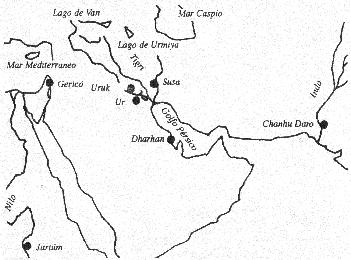
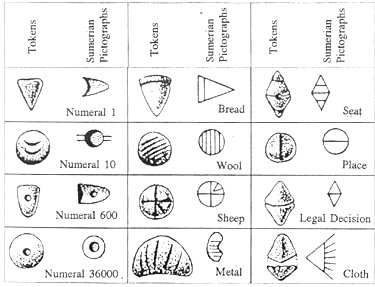
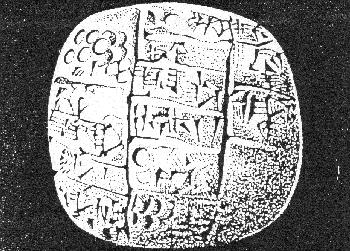
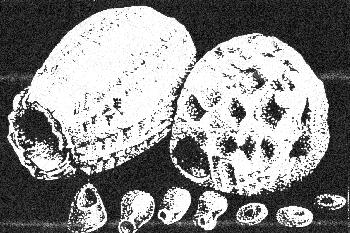
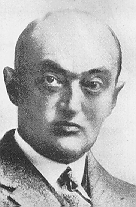 This
is also the pitfall which Schumpeter himself falls into when he discusses
Aristotle's theory: «The Aristotelian theory of the logical origin
of money may pass muster -at a push- as a verifiable theory of its historical
origin. Such instances as the Semitic shekel or the tea-money of Mongolian
nomades (both of them with intrinsic value) sufice to show its
This
is also the pitfall which Schumpeter himself falls into when he discusses
Aristotle's theory: «The Aristotelian theory of the logical origin
of money may pass muster -at a push- as a verifiable theory of its historical
origin. Such instances as the Semitic shekel or the tea-money of Mongolian
nomades (both of them with intrinsic value) sufice to show its